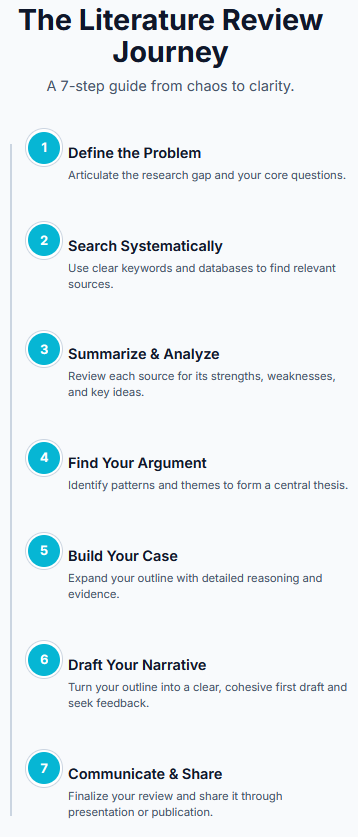For many researchers, the literature review is the most daunting part of any project. It can feel like an endless, overwhelming task of sifting through a sea of papers, with no clear end in sight. But a literature review is far more than a simple summary of what others have said; it is the intellectual foundation upon which your entire research project is built. It's where you map the existing territory, identify a critical gap, and stake your claim.
Breaking this process down into a clear, strategic framework transforms it from a source of anxiety into a manageable and even exciting journey of discovery. This guide will walk you through a 7-step process to move from chaos to clarity and craft a literature review that is insightful, compelling, and truly impactful.
Part 1: The Foundation – Defining Your Scope and Strategy
Before you can start reading, you must first become an architect. This initial phase is about defining the purpose and boundaries of your review.
- Step 1: Define the Problem with Precision
Your literature review must be anchored to a clear and specific problem. Why is this review necessary? What specific question are you trying to answer? Start by writing 2-3 pages that articulate the problem, explain why it matters, and identify the gap in the existing research that you intend to fill. A vague starting point will lead to a vague and unfocused review. - Step 2: Conduct a Systematic Literature Search
Once you know your problem, you need to find the right sources. This process should be systematic, not random. Document your methodology: What keywords and databases did you use? What were your inclusion and exclusion criteria? This methodical approach ensures your review is comprehensive and defensible, and it forms the basis of your methods section.
Part 2: The Synthesis – Moving from Reading to Argument
This is where the core intellectual work happens. You move from being a passive reader to an active synthesizer of information, identifying patterns and building your own unique argument.
- Step 3: Summarize and Analyze Each Source
As you review each article, go beyond a simple summary. For each source, identify its core focus, its key strengths, and, most importantly, its weaknesses or limitations. Writing annotated summaries for your most critical sources is an excellent way to practice this analytical approach. - Step 4: Define Your Central Argument
After analyzing your sources, it's time to zoom out. What patterns, themes, or contradictions emerge from the literature? What are your key discoveries? This is where you organize your thinking and define the central argument that will form the backbone of your review. A simple outline is an invaluable tool at this stage. - Step 5: Build Your Detailed Argument
With your outline as a guide, expand on your points. Back up every claim with logic and evidence from your sources. Explain your reasoning step-by-step, showing the reader how you arrived at your conclusions. This is where you construct the detailed, evidence-based case for your central argument.
Part 3: The Narrative – From Draft to Final Impact
The final phase is about transforming your argument into a clear, compelling, and polished piece of writing.
- Step 6: Draft Your Narrative and Seek Feedback
Turn your detailed outline into a full first draft. Focus on creating a clear and logical flow, using headings, examples, and smooth transitions to guide the reader. Crucially, this is the time to seek feedback. A structured feedback loop—from peers to your supervisor to outside experts—is the fastest way to refine your work. - Step 7: Communicate Your Findings Effectively
Your final task is to share your review with the world. Use visuals like graphs and tables to clarify complex points and help tell your story. Whether you are presenting at a conference or publishing in a journal, your goal is to communicate your findings in a way that is not only informative but also engaging and memorable.
Final Thoughts
A literature review is one of the most challenging, yet rewarding, intellectual tasks in research. By approaching it with a clear, systematic process, you can turn an overwhelming chore into a powerful tool for discovery—one that not only supports your research but stands as a significant scholarly contribution in its own right.
Frequently Asked Questions (FAQ)
- How do I know when I've read enough?
You'll likely never feel like you've read "enough," but a good indicator is when you start seeing the same authors, studies, and concepts repeated without discovering significant new information. This is known as reaching "theoretical saturation." At this point, you likely have a strong grasp of the field's key conversations. - What's the difference between an annotated bibliography and a literature review?
An annotated bibliography is a list of sources, where each entry is followed by a brief summary and analysis (the annotation). It is a collection of discrete summaries. A literature review, on the other hand, synthesizes these sources into a single, cohesive narrative that builds an argument about the state of the field. - How do I organize the body of my literature review?
Avoid organizing it source-by-source (e.g., "Smith (2020) found... then Jones (2021) found..."). Instead, organize it thematically or chronologically. A thematic structure groups sources by common topics or arguments, which is generally more effective for building your own argument.


